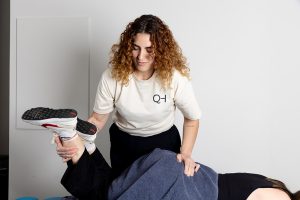Written by: Richard Domenic Simeoni, Doctor of Physiotherapy
When people hear ‘physiotherapy’, many automatically think of sports injuries or rehab after surgery. But physiotherapy is just as—if not more—important for everyone as we age. In fact, I’d argue that consistent physiotherapy can be one of the most powerful tools for maintaining independence, reducing falls, and feeling stronger and steadier later in life.
As a physiotherapist with over a decade of experience working with older adults, I’ve seen firsthand how even small improvements in movement, strength, or confidence can drastically improve someone’s quality of life.
Here is a closer look at several ways that physiotherapy can help us as we age:
Bone Density – Use It or Lose It
As we age, our bones naturally lose density. This is especially common in post-menopausal women, but it affects everyone to some degree. The trouble is, low bone density increases the risk of fractures, especially after a fall.
Physiotherapy helps in two big ways:
- Weight-bearing exercise: We guide clients through safe, targeted movements that apply gentle stress to the bones, encouraging the body to build and maintain bone density. This includes exercises like standing leg lifts, squats, walking drills, and more.
- Fall prevention: Even if someone has low bone density, we focus on reducing the likelihood of a fall in the first place.
Think of your bones like a muscle — they respond to the right kind of pressure. Sitting too much and avoiding movement actually speeds up bone loss. Exercising and moving throughout our day delays or reduces this bone loss.
Muscle Mass – Strength for Daily Life
We all lose muscle mass as we age. It’s part of the natural ageing process (technically called sarcopenia), but that doesn’t mean we’re powerless against it. The good news is that muscles respond to strength training at any age. Even in your 80s or 90s.
In physiotherapy, we work to rebuild strength in the legs, hips, arms, and core. These aren’t just ‘gym exercises’—we train muscles that help with:
- Getting in and out of a chair
- Climbing steps
- Carrying groceries
- Preventing wobbles and slips
The overall goal of Physiotherapy at this stage is not to ‘bulk up’. It’s about having the muscle strength to stay mobile and independent.
Incredibly, even light resistance exercises (like using resistance bands or bodyweight training) performed consistently can slow or even reverse age-related muscle loss.
Balance – Improving Your Confidence
Falls are one of the most common reasons older adults end up in the hospital. Often, it’s not the fall itself, it’s what comes after: fractures, fear, reduced confidence, and sometimes a quick decline in mobility.
In physiotherapy, balance training is one of the key tools we use to keep people safe and independent.
This includes:
- Specific balance drills: Standing on one leg, stepping over obstacles, or changing directions safely.
- Coordination and reaction time: Training the body to respond more quickly and recover when balance is thrown off.
- Walking re-training: Adjusting stride, improving walking patterns, and making sure the body moves efficiently.
Good balance isn’t just about strong legs, it’s about communication between the brain, muscles, and joints. That’s what a physiotherapist works on.
Final Thoughts
Physiotherapy isn’t just for fixing problems, it’s for preventing them. For the elderly, it’s about protecting independence, staying active, and living with confidence.
If you or someone you love is feeling a little unsteady, noticing a drop in energy, or struggling with everyday tasks, know that there are safe, targeted, and effective physiotherapy strategies that can help.
To get started, speak with a physiotherapist in Sydney who understands the needs of older adults and can create a program to support your goals. Ready to take the next step? Book now and begin your plan towards strength, balance, and confidence.




